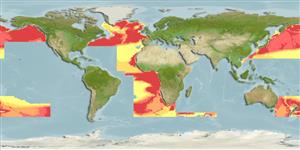>
Notacanthiformes (Halosaurs and deep-sea spiny eels) >
Notacanthidae (Deep-sea spiny eels)
Etymology: Polyacanthonotus: Greek, poly = a lot of + Greek, akantha = thorn + Greek,noton = back (Ref. 45335); challengeri: Named after the H.M.S. Challenger (Ref. 6885).
Eponymy: ‘HMS Challenger’ was a deep-sea research vessel, famous for the Challenger Expedition (1872–1876) which contributed hugely to oceanography and led to the discovery of over 4,000 previously unknown species. (Ref. 128868), visit book page.
More on author: Vaillant.
Environment: milieu / climate zone / depth range / distribution range
Ecologia
marinhas batipelágico; intervalo de profundidade 777 - 4560 m (Ref. 50610), usually 2000 - 3000 m (Ref. 6728). Deep-water; - 50°S
North Pacific: Japan, Bering Sea and British Columbia, Canada (Ref. 6885), also south to Oregon, USA (Ref. 35578). South Pacific: known form one specimen collected near New Zealand. Southeast Atlantic: South Africa. Southern Ocean: known from one specimen collected near the Kerguelen Islands. Mainly antitropical (Ref. 5165) but reported from Azores, Canary Islands and Morocco (Ref. 6728).
Tamanho / Peso / Idade
Maturity: Lm ? range ? - ? cm
Max length : 60.0 cm TL macho/indeterminado; (Ref. )
Espinhos dorsais (total) : 32 - 35; Raios dorsais moles (total) : 0; Vértebras: 242 - 244. Caudal fin very small; anal fin with 161-162 rays altogether, 26-35 of which are spines, long, low, confluent with caudal; pectorals with a fleshy base (Ref. 6885). Cream to faintly pink, possibly with light brown markings; black on posterior margins of anal and caudal fins; black on posterior edge of gill cover, lining of mouth and gill chamber, and parts of peritoneum (Ref. 6885).
Feeds on benthic invertebrates, especially amphipods, polychaetes and mysids (Ref. 6728).
Life cycle and mating behavior
Maturidade | Reprodução | Desova | Ovos | Fecundidade | Larvas
Gon, O., 1990. Notacanthidae. p. 100-101. In O. Gon and P.C. Heemstra (eds.) Fishes of the Southern Ocean. J.L.B. Smith Institute of Ichthyology, Grahamstown, South Africa. (Ref. 5165)
Categoria na Lista Vermelha da IUCN (Ref. 130435: Version 2024-2)
Ameaça para o homem
Harmless
Utilização humana
Ferramentas
Relatórios especiais
Descarregue XML
Fontes da internet
Estimates based on models
Preferred temperature (Ref.
123201): 1.5 - 3.4, mean 2.4 °C (based on 2854 cells).
Phylogenetic diversity index (Ref.
82804): PD
50 = 0.5630 [Uniqueness, from 0.5 = low to 2.0 = high].
Bayesian length-weight: a=0.00102 (0.00046 - 0.00225), b=3.06 (2.88 - 3.24), in cm total length, based on all LWR estimates for this body shape (Ref.
93245).
Nível Trófico (Ref.
69278): 3.2 ±0.42 se; based on food items.
Resiliência (Ref.
120179): Baixo, tempo mínimo de duplicação da população 4,5 - 14 anos (Assuming tmax>10).
Fishing Vulnerability (Ref.
59153): Moderate vulnerability (44 of 100).
